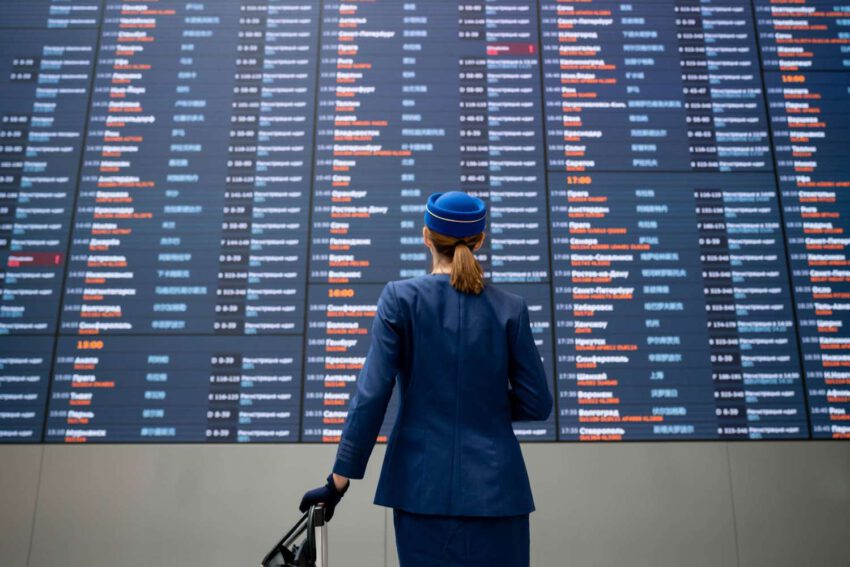Flight times are a funny thing. Of course, every flight has them — there is always a departure time and an arrival time that’s published online months ahead of the flight. But if you’re a frequent flier, you might’ve noticed that those times are rarely accurate.
Why? Well, many of the expected culprits are to blame. Departure times can be pushed back due to a slow boarding process, while arrival times can be pushed back due to any delays during the travel experience, whether that’s bad weather or heavy traffic. So try as an airline might, it’s almost impossible to time flights exactly to the minute.
That said, airlines certainly know and expect this, which is why they have complex methods for formulating flight times, incorporating all kinds of data from previous performance within the National Airspace System. Ultimately, they do their best to estimate flight times accurately to keep things operating as smoothly as possible — and that often includes adding some extra time to the schedule in the event of unexpected delays.
Here’s what you need to know about how flight times are determined, including what’s considered an “on-time arrival.”
What are departure and arrival times?
While many travelers might assume departure and arrival times refer to wheels up and wheels down, that’s not the case. The “timed” portion of the air travel experience — from departure time to arrival time — is called block time, and it includes some time spent on the ground.
“Block time is defined as brake release at the departure gate and brakes set at the arrival gate,” aviation expert Don Wolford tells Travel + Leisure.
Meet the Expert
Don Wolford has more than 35 years of experience as a flight dispatcher, air traffic flow coordinator, and aerospace consultant working for and with the global airline community.
That means that the published time you see online is not only the time spent in the air — it also includes taxiing between the gate and the runway. (An interesting aside: Pilots and flight attendants are only paid for block time, and that doesn’t include boarding.)
Related: How Many Planes Are in the Air Right Now?
How do airlines determine block time?
Airlines are big into data analysis, so a complex algorithm takes various data and formulates a reasonable block time for a flight. “Factors such as average taxi out and in, average en-route time, chronic air traffic delays, and the like are considered in the calculation of the block time,” says Wolford.
And the results are different for every airport, every route, and every hour of the day. That’s why different flights on the same route — even flights on the same airline — can have different published durations. (You may even find that third-party flight time calculators show times that are minutes or hours different compared to published flight schedules).
Of course, there can always be unexpected delays, which is why flights are not necessarily on schedule to the exact minute. That said, most flights are actually considered “on time” even if they’re a little late — and overall schedules are designed to accommodate this.
:max_bytes(150000):strip_icc()/TAL-airport-flight-time-FLIGHTTIMES1123-a4971794d3ea45608be0f79f06bf3ecf.jpg)
Maria Korneeva/Getty Images
When is a flight considered on time or late?
The U.S. Department of Transportation (DOT) tracks airlines’ on-time performance, and it has established that any flight arriving up to 15 minutes after its scheduled arrival time is actually “on time.” So when you’re making travel plans — say, booking a car from the airport in advance — consider adding 15 minutes to your arrival time, just in case. (And that doesn’t account for the time it takes to deplane, go through immigration and customs, and retrieve luggage.)
If a flight is regularly late, the DOT might step in with sanctions. “Flights that operate more than 15 minutes late chronically may result in a DOT order to revise the published schedule,” says Wolford. “The DOT also publishes a monthly ‘list of shame‘ for all chronically delayed flights. So, as you might imagine, airlines take a conservative view when publishing schedules.”
Related: How to Track a Flight in Real Time
Do airlines pad their flight times?
Yes, airlines do gently pad flight times as a matter of operational success. “There is so much instability in the National Airspace System that airlines are forced to add block time to the schedule for almost all flights,” says Wolford. “A good example of this is the block time for a typical New York to Los Angeles flight, which is scheduled about 90 minutes longer than in 1959.” He notes that about one-third of this additional time is due to the fact that we fly planes slower today as a matter of fuel efficiency; the rest is due to all sorts of delays.
Padding the flight time also benefits passengers. Because most airlines in the U.S. operate on a hub-and-spoke model — passengers are funneled from smaller airports to major hubs, then onward to either other hubs or smaller airports — connection time is crucial. “Up to 60 percent of the passengers may be connecting to another flight at the hub, so schedule integrity is important from that aspect,” says Wolford.
But airlines don’t want to pad flight times too much. While on-time arrivals are a key metric for airlines, there’s also a financial incentive to be as accurate as possible for block times. “Airlines invest significant resources into operational analysis,” says Wolford. “When these analysts are able to find a way to reduce block time, even by a few minutes, the cost saving is enormous, just from pilot and flight attendant pay, plus manpower below the wing at the airports, such as the ramp, gate, and maintenance teams.”
